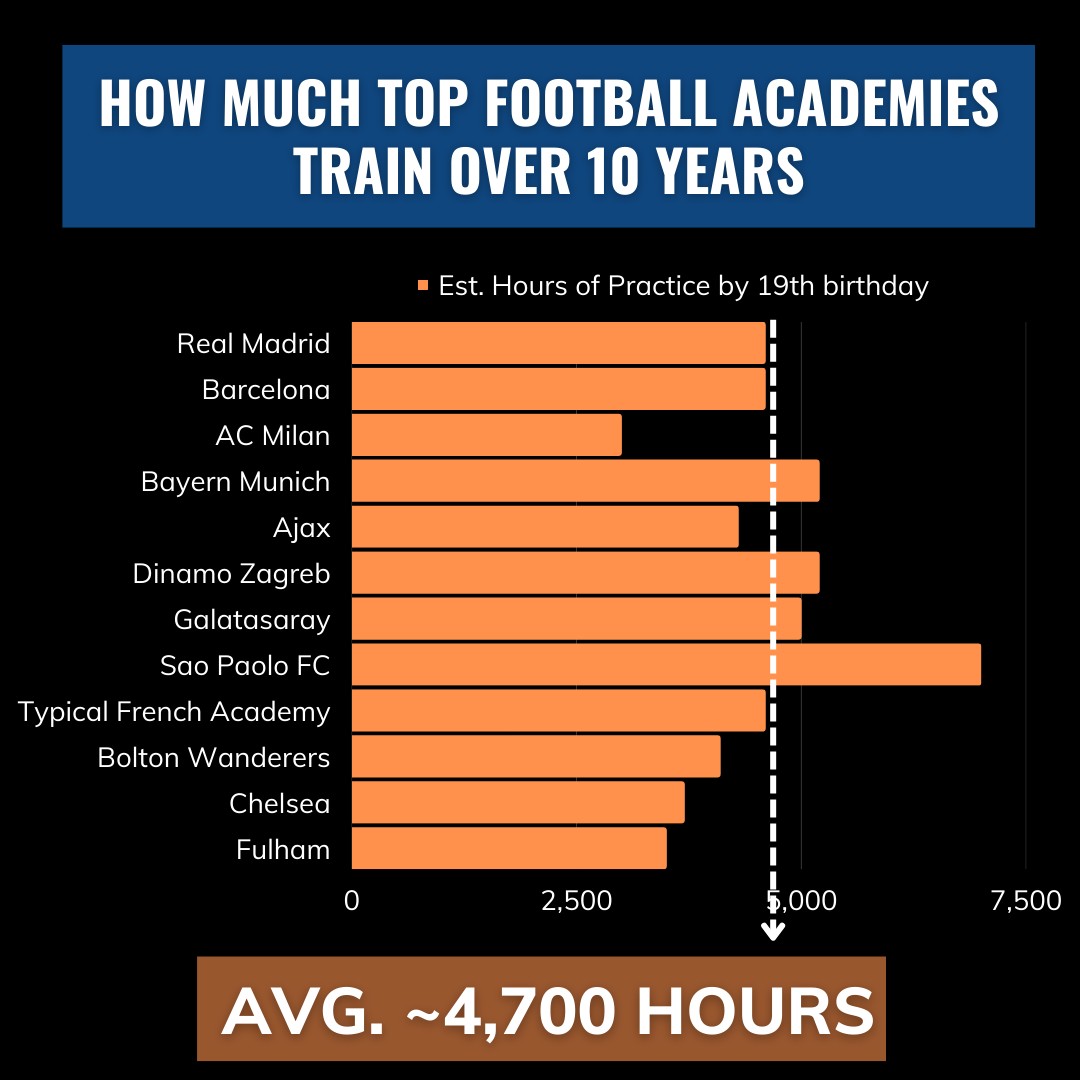Best Individual Training for Athletes: How to Train Smarter
The pandemic taught athletes an important lesson I wish I had learned earlier in my career: we must take control of our development to become great. That means putting in the work by yourself and not relying solely on a coach/trainer to achieve your goals. Even though this might seem obvious, I want to start by explaining the 2 main reasons why individual training is essential for any athlete looking to become truly great.
2 Reasons Athletes Need Individual Training
#1 You don't get enough hours with just team training.
Research by Andres Ericsson suggests it takes approximately 10,000 hours of deliberate practice over 10 years to become great at any sport. To get an idea if athletes could do this with just team training, I decided to look at how much team training is done over 10 years (ages 9 to 19) for 16 of the world's most prestigious youth soccer academies (see graph below). The average time spent on team training is ~4,700 hours, which is less than half of the 10,000 hours that it takes to become a great athlete (source). This data suggests that the best from these academies also likely spent a significant amount of time training by themselves. Three real-life examples that demonstrate this include:
This breakdown of how Kyrie Irving got to 10,000 hours
This interview with Kobe Bryant
This picture of Martin Odegaard’s training schedule as a 13-year-old
#2 You need time to work on your weaknesses.
Improving your weaknesses is essential to become great, but team training is not specifically designed to do this. Coaches have to worry about countless other things (i.e. other players on the team, tactics for upcoming matches, etc.), so it’s your responsibility to improve your weaknesses outside of the team environment. One option could be to hire a personal trainer, but with the average personal trainer charging $80/hr and with 5,400 hours remaining, this would cost a whopping $432,000 over 10 years. Also, I can attest from personal experience that learning how to improve weaknesses on your own helps develop a sense of pride and autonomy which can benefit athletes long term by helping them learn more about the development process and increase motivation.
So now that we know why we need individual training, what's wrong with how it's typically done?
4 Problems with Individual Training
Individual training inherently lacks 4 essential qualities that are in all dynamic team and individual ball sports (i.e. soccer, hockey, basketball, baseball, lacrosse, tennis, football, rugby, handball, etc.).
#1 No external focus
When training alone, athletes tend to have their eyes down and attention focused on the movement itself, but in competition, you must be able to perform skills with your eyes up and attention focused on the environment around you.
#2 No decision-making
When training alone, athletes can only perform physical repetitions, but in competition, you must be able to perform skills while making split-second decisions.
#3 No randomness or unpredictability
When training alone, athletes tend to practice one skill at a time in a constant, monotonous pattern (also known as blocked practice) because it leads to quick short-term improvements, but research shows this does not lead to great long-term retention or transfer to competition (Shea et al., 1979).
#4 No external time pressure
When training alone, athletes do not have the external time pressure to perform skills at a specific moment or at game speed.
So, how can we incorporate these 4 elements while training by ourselves?
A More Effective Approach: Cognitive-Motor Training (CMT)
Cognitive-motor training (CMT) is a methodology designed using the SwitchedOn app to address these problems. The app provides randomized visual and audio cues (colors, numbers, arrows, etc.) that athletes place near eye level and react to with sports-specific movements. This helps solve these problems because it:
Requires athletes to get their eyes up and focus externally on information coming from the app.
Requires athletes to make decisions based on the stimulus that appears.
Creates a random and unpredictable training environment since they have to perform actions based on the randomized stimulus.
Challenges athletes to perform at game speed because they must keep up with the speed at which the stimulus changes from one to another.
Research by Lucia et al., 2022 compared traditional individual training and cognitive-motor training in basketball players over 6 weeks and found:
The CMT group had 17% greater improvements in sports performance
The CMT group had 28% greater improvements in decision-making accuracy
The CMT group had heightened activity in brain areas dealing with anticipation, proactive inhibition, and top-down attention.
Here are 4 drill examples. Press “TAP TO TRY” while on your mobile device to get taken directly to the drill in the app.
Rapid Reactions
Bells to Dynamic Sole Roll
Stationary Ball-Handling
Around 4 Pucks or Foot Pass
How Much Should I Be Training Each Day?
In the book Deep Work, researcher Andres Ericcson suggests elite athletes can train for a maximum of 4 hours of intense, focused training each day; novice athletes might only be able to do 1 hour per day.
Key Takeaways
Athletes who want to become great likely must do ~5000 hours of training outside their team environment.
Individual training lacks 4 essential components (external focus, decision-making, unpredictability, and pressure).
Cognitive-motor training addresses these issues, and research has shown it’s more effective than traditional individual training.
Athletes should not perform more than 4 hours of deliberate training per day.
Download the SwitchedOn app for free using the buttons below to start utilizing cognitive-motor training using just your mobile device!

